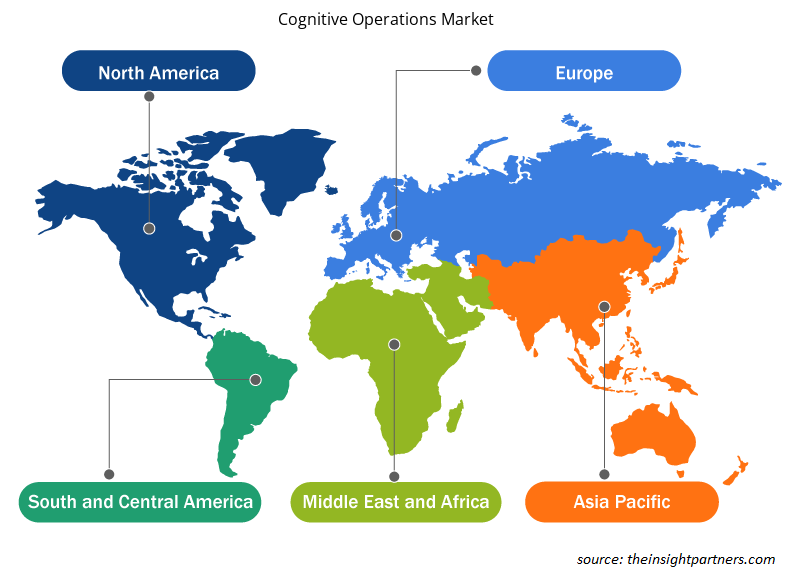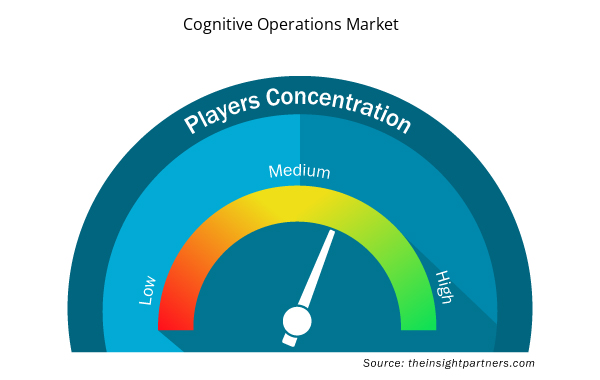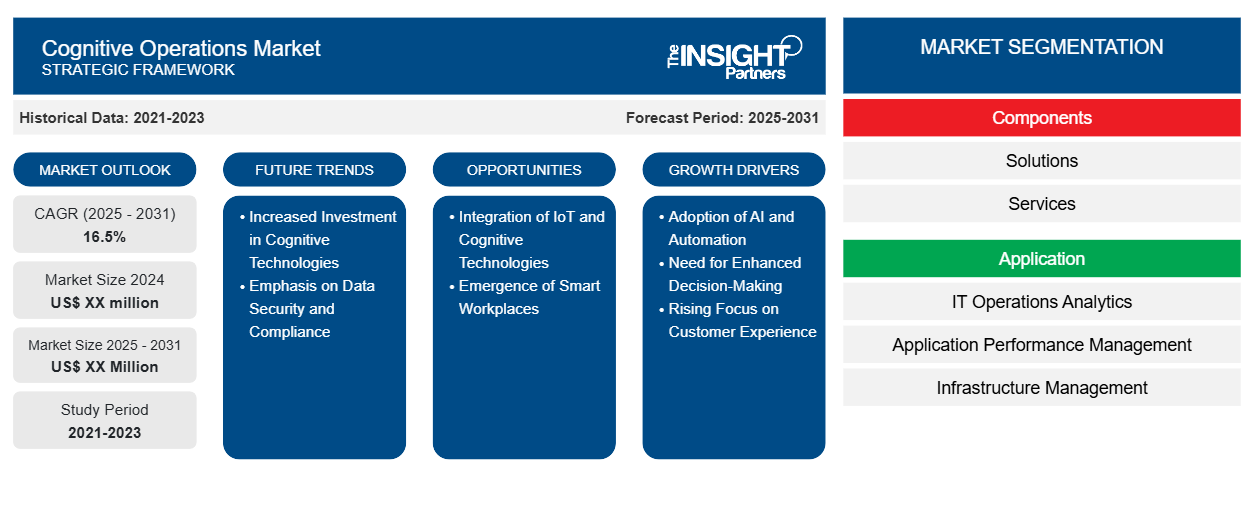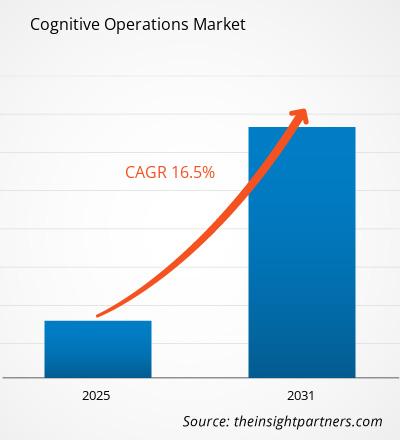Es wird erwartet, dass der Markt für kognitive Operationen von 2023 bis 2031 eine durchschnittliche jährliche Wachstumsrate (CAGR) von 16,5 % verzeichnet, wobei die Marktgröße von XX Millionen US-Dollar im Jahr 2023 auf XX Millionen US-Dollar im Jahr 2031 wächst.
Der Bericht ist segmentiert nach Komponenten (Lösungen, Services); Anwendung (IT-Betriebsanalyse, Anwendungsleistungsmanagement, Infrastrukturmanagement, Netzwerkanalyse, Sicherheitsanalyse, Sonstiges); Unternehmensgröße (Großunternehmen, KMU); Bereitstellungstyp (Cloud-basiert, Vor-Ort); Branchenvertikale (BFSI, IT und Telekommunikation, Gesundheitswesen und Biowissenschaften, Medien und Unterhaltung, Fertigung, Regierung, Einzelhandel und E-Commerce, Sonstiges). Die globale Analyse ist weiter auf regionaler Ebene und nach wichtigen Ländern aufgeschlüsselt. Der Bericht bietet den Wert in USD für die oben genannte Analyse und Segmente
Zweck des Berichts
Der Bericht Cognitive Operations Market von The Insight Partners zielt darauf ab, die aktuelle Landschaft und das zukünftige Wachstum sowie die wichtigsten treibenden Faktoren, Herausforderungen und Chancen zu beschreiben. Dies wird verschiedenen Geschäftspartnern Einblicke geben, wie zum Beispiel:
- Technologieanbieter/-hersteller: Um die sich entwickelnde Marktdynamik zu verstehen und die potenziellen Wachstumschancen zu kennen, damit sie fundierte strategische Entscheidungen treffen können.
- Investoren: Durchführung einer umfassenden Trendanalyse hinsichtlich der Marktwachstumsrate, der finanziellen Marktprognosen und der Chancen entlang der Wertschöpfungskette.
- Regulierungsbehörden: Zur Regulierung von Richtlinien und Überwachungsaktivitäten auf dem Markt mit dem Ziel, Missbrauch zu minimieren, das Vertrauen der Anleger zu bewahren und die Integrität und Stabilität des Marktes aufrechtzuerhalten.
Kognitive Operationen Marktsegmentierung
Komponenten
- Lösungen
- Dienstleistungen
Anwendung
- IT-Betriebsanalyse
- Anwendungsleistungsmanagement
- Infrastrukturmanagement
- Netzwerkanalyse
- Sicherheitsanalysen
- Sonstiges
Unternehmensgröße
- Große Unternehmen
- KMU
Bereitstellungstyp
- Cloudbasiert
- Vor Ort
Bereitstellungstyp
- Cloudbasiert
- Vor Ort
Passen Sie diesen Bericht Ihren Anforderungen an
Sie erhalten kostenlos individuelle Anpassungen an jedem Bericht, einschließlich Teilen dieses Berichts oder einer Analyse auf Länderebene, eines Excel-Datenpakets sowie tolle Angebote und Rabatte für Start-ups und Universitäten.
- Holen Sie sich die wichtigsten Markttrends aus diesem Bericht.Dieses KOSTENLOSE Beispiel umfasst eine Datenanalyse von Markttrends bis hin zu Schätzungen und Prognosen.
Wachstumstreiber auf dem Markt für kognitive Operationen
- Einführung von KI und Automatisierung: Die zunehmende Einführung von künstlicher Intelligenz (KI) und Automatisierungstechnologien ist ein Haupttreiber des Marktes für kognitive Operationen. Unternehmen nutzen KI, um Abläufe zu rationalisieren, Entscheidungsprozesse zu verbessern und die Effizienz zu steigern. Kognitive Operationen nutzen Algorithmen des maschinellen Lernens, um große Datensätze zu analysieren, Muster zu erkennen und Routineaufgaben zu automatisieren, was zu schnelleren Reaktionen und geringeren Betriebskosten führt. Da Unternehmen versuchen, ihre Arbeitsabläufe zu optimieren und wettbewerbsfähig zu bleiben, steigt die Nachfrage nach Lösungen für kognitive Operationen weiter an und treibt das Marktwachstum voran.
- Bedarf an verbesserter Entscheidungsfindung: Unternehmen sind mit einem ständig wachsenden Datenvolumen und einer immer größeren Komplexität ihrer Betriebsabläufe konfrontiert, was zu einem erhöhten Bedarf an verbesserten Entscheidungsfindungsfähigkeiten führt. Kognitive Operationen nutzen erweiterte Analysen und KI-gestützte Erkenntnisse, um strategische Entscheidungsfindungen zu unterstützen und Unternehmen zu ermöglichen, effektiver auf Marktveränderungen zu reagieren. Durch die Bereitstellung von Echtzeit-Datenanalysen und prädiktiven Erkenntnissen helfen kognitive Operationen Unternehmen, fundierte Entscheidungen zu treffen und so die Gesamtleistung und Agilität zu verbessern. Dieser Bedarf an besserer Entscheidungsfindung treibt die Nachfrage nach kognitiven Operationslösungen in verschiedenen Branchen voran.
- Zunehmender Fokus auf das Kundenerlebnis: Der Schwerpunkt auf die Verbesserung des Kundenerlebnisses ist ein wichtiger Treiber des Marktes für kognitive Operationen. Unternehmen sind sich zunehmend bewusst, dass die Bereitstellung außergewöhnlicher Kundenerlebnisse entscheidend ist, um Kunden zu binden und Wachstum zu erzielen. Kognitive Operationen ermöglichen es Unternehmen, Kundeninteraktionen, Präferenzen und Feedback in Echtzeit zu analysieren, was personalisierte Dienste und proaktive Problemlösungen ermöglicht. Durch die Nutzung kognitiver Technologien können Unternehmen die Kundenbindung und -zufriedenheit verbessern und so das Wachstum des Marktes für kognitive Operationen vorantreiben.
Zukünftige Trends im Markt für kognitive Operationen
- Erhöhte Investitionen in kognitive Technologien: Ein bemerkenswerter Trend auf dem Markt für kognitive Operationen sind die wachsenden Investitionen in kognitive Technologien durch Unternehmen aus verschiedenen Branchen. Unternehmen erkennen das Potenzial kognitiver Operationen, um Innovationen voranzutreiben, die Effizienz zu verbessern und die Kundenzufriedenheit zu steigern. Dieser Investitionstrend spiegelt sich in der Entwicklung fortschrittlicher Lösungen wider, die KI, maschinelles Lernen und Datenanalyse beinhalten. Da Unternehmen der digitalen Transformation Priorität einräumen, wird erwartet, dass die Nachfrage nach kognitiven Operationstechnologien steigt, was zu erheblichen Fortschritten auf dem Markt führt.
- Schwerpunkt auf Datensicherheit und Compliance: Mit der zunehmenden Abhängigkeit von kognitiven Operationen steigt auch der Schwerpunkt auf Datensicherheit und Compliance. Unternehmen werden sich der Risiken im Zusammenhang mit Datenschutzverletzungen und gesetzlichen Anforderungen immer bewusster. Infolgedessen gibt es einen wachsenden Trend zur Implementierung robuster Sicherheitsmaßnahmen und Compliance-Protokolle innerhalb kognitiver Operations-Frameworks. Unternehmen investieren in Technologien, die Datenintegrität, Vertraulichkeit und Einhaltung von Branchenvorschriften gewährleisten, wodurch die Datensicherheit zu einem kritischen Schwerpunktbereich im Markt für kognitive Operationen wird.
Marktchancen für kognitive Operationen
- Integration von IoT und kognitiven Technologien: Die Integration von IoT-Geräten (Internet of Things) mit kognitiven Technologien bietet eine große Chance auf dem Markt für kognitive Operationen. Da immer mehr Geräte miteinander verbunden werden, ist das generierte Datenvolumen immens. Kognitive Operationen können diese Daten analysieren, um umsetzbare Erkenntnisse abzuleiten, die Prozesse optimieren, das Ressourcenmanagement verbessern und die Betriebseffizienz steigern. Unternehmen, die IoT-Daten mit kognitiver Analytik nutzen, können ihre Abläufe erneuern und sich einen Wettbewerbsvorteil verschaffen, was diese Integration zu einer wichtigen Wachstumschance auf dem Markt macht.
- Entstehung intelligenter Arbeitsplätze: Der Aufstieg intelligenter Arbeitsplätze, der durch die digitale Transformation und Trends zur Fernarbeit vorangetrieben wird, bietet erhebliche Chancen für den Markt für kognitive Operationen. Unternehmen setzen zunehmend kognitive Tools ein, um die Zusammenarbeit, Produktivität und Kommunikation zwischen Remote-Teams zu erleichtern. Durch die Implementierung kognitiver Lösungen, die die Workflow-Automatisierung, das Aufgabenmanagement und den Datenaustausch verbessern, können Unternehmen effizientere und flexiblere Arbeitsumgebungen schaffen. Dieser Wandel hin zu intelligenten Arbeitsplätzen bietet Anbietern kognitiver Operationen eine einzigartige Gelegenheit, maßgeschneiderte Lösungen zu entwickeln, die den sich entwickelnden Anforderungen am Arbeitsplatz gerecht werden.
Regionale Einblicke in den Markt für kognitive Operationen
Die regionalen Trends und Faktoren, die den Markt für kognitive Operationen im gesamten Prognosezeitraum beeinflussen, wurden von den Analysten von Insight Partners ausführlich erläutert. In diesem Abschnitt werden auch die Marktsegmente und die Geografie für kognitive Operationen in Nordamerika, Europa, im asiatisch-pazifischen Raum, im Nahen Osten und Afrika sowie in Süd- und Mittelamerika erörtert.

- Holen Sie sich die regionalspezifischen Daten für den Markt für kognitive Operationen
Umfang des Marktberichts zu kognitiven Operationen
| Berichtsattribut | Details |
|---|---|
| Marktgröße im Jahr 2023 | XX Millionen US-Dollar |
| Marktgröße bis 2031 | XX Millionen US-Dollar |
| Globale CAGR (2023 - 2031) | 16,5 % |
| Historische Daten | 2021-2022 |
| Prognosezeitraum | 2024–2031 |
| Abgedeckte Segmente | Nach Komponenten
|
| Abgedeckte Regionen und Länder | Nordamerika
|
| Marktführer und wichtige Unternehmensprofile |
|
Marktdichte kognitiver Operationen: Auswirkungen auf die Geschäftsdynamik verstehen
Der Markt für kognitive Operationen wächst rasant, angetrieben durch die steigende Nachfrage der Endnutzer aufgrund von Faktoren wie sich entwickelnden Verbraucherpräferenzen, technologischen Fortschritten und einem größeren Bewusstsein für die Vorteile des Produkts. Mit steigender Nachfrage erweitern Unternehmen ihr Angebot, entwickeln Innovationen, um die Bedürfnisse der Verbraucher zu erfüllen, und nutzen neue Trends, was das Marktwachstum weiter ankurbelt.
Die Marktteilnehmerdichte bezieht sich auf die Verteilung der Firmen oder Unternehmen, die in einem bestimmten Markt oder einer bestimmten Branche tätig sind. Sie gibt an, wie viele Wettbewerber (Marktteilnehmer) in einem bestimmten Marktraum im Verhältnis zu seiner Größe oder seinem gesamten Marktwert präsent sind.
Die wichtigsten auf dem Markt für kognitive Operationen tätigen Unternehmen sind:
- AppDynamics (Cisco)
- Appnomic
- BMC Software, Inc.
- HCL Technologies Limited
- IBM Corporation
Haftungsausschluss : Die oben aufgeführten Unternehmen sind nicht in einer bestimmten Reihenfolge aufgeführt.

- Überblick über die wichtigsten Akteure auf dem Markt für kognitive Operationen
Wichtige Verkaufsargumente
- Umfassende Abdeckung: Der Bericht deckt die Analyse von Produkten, Diensten, Typen und Endbenutzern des Marktes für kognitive Operationen umfassend ab und bietet einen ganzheitlichen Überblick.
- Expertenanalyse: Der Bericht basiert auf dem umfassenden Verständnis von Branchenexperten und Analysten.
- Aktuelle Informationen: Der Bericht stellt durch die Abdeckung aktueller Informationen und Datentrends Geschäftsrelevanz sicher.
- Anpassungsoptionen: Dieser Bericht kann angepasst werden, um spezifische Kundenanforderungen zu erfüllen und die Geschäftsstrategien optimal anzupassen.
Der Forschungsbericht zum Markt für kognitive Operationen kann daher dabei helfen, die Branchensituation und Wachstumsaussichten zu entschlüsseln und zu verstehen. Obwohl es einige berechtigte Bedenken geben kann, überwiegen die allgemeinen Vorteile dieses Berichts tendenziell die Nachteile.
- Historische Analyse (2 Jahre), Basisjahr, Prognose (7 Jahre) mit CAGR
- PEST- und SWOT-Analyse
- Marktgröße Wert/Volumen – Global, Regional, Land
- Branche und Wettbewerbsumfeld
- Excel-Datensatz



Report Coverage
Revenue forecast, Company Analysis, Industry landscape, Growth factors, and Trends

Segment Covered
This text is related
to segments covered.

Regional Scope
North America, Europe, Asia Pacific, Middle East & Africa, South & Central America

Country Scope
This text is related
to country scope.
Häufig gestellte Fragen
Some of the customization options available based on the request are an additional 3-5 company profiles and country-specific analysis of 3-5 countries of your choice. Customizations are to be requested/discussed before making final order confirmation# as our team would review the same and check the feasibility
The report can be delivered in PDF/PPT format; we can also share excel dataset based on the request
Development of smart 3D scanners to play a significant role in the global cognitive operations market in the coming years
Growing focus on quality control and inspection and growing technological advancements are the major factors driving the cognitive operations market
The Cognitive Operations Market is estimated to witness a CAGR of 16.5% from 2023 to 2031
Trends and growth analysis reports related to Technology, Media and Telecommunications : READ MORE..
1.AppDynamics (Cisco)
2.Appnomic
3.BMC Software, Inc.
4.HCL Technologies Limited
5.IBM Corporation
6.Interlink Software Services Ltd.
7.Micro Focus
8.New Relic, Inc.
9.ServiceNow
10.Splunk Inc.
The Insight Partners performs research in 4 major stages: Data Collection & Secondary Research, Primary Research, Data Analysis and Data Triangulation & Final Review.
- Data Collection and Secondary Research:
As a market research and consulting firm operating from a decade, we have published and advised several client across the globe. First step for any study will start with an assessment of currently available data and insights from existing reports. Further, historical and current market information is collected from Investor Presentations, Annual Reports, SEC Filings, etc., and other information related to company’s performance and market positioning are gathered from Paid Databases (Factiva, Hoovers, and Reuters) and various other publications available in public domain.
Several associations trade associates, technical forums, institutes, societies and organization are accessed to gain technical as well as market related insights through their publications such as research papers, blogs and press releases related to the studies are referred to get cues about the market. Further, white papers, journals, magazines, and other news articles published in last 3 years are scrutinized and analyzed to understand the current market trends.
- Primary Research:
The primarily interview analysis comprise of data obtained from industry participants interview and answers to survey questions gathered by in-house primary team.
For primary research, interviews are conducted with industry experts/CEOs/Marketing Managers/VPs/Subject Matter Experts from both demand and supply side to get a 360-degree view of the market. The primary team conducts several interviews based on the complexity of the markets to understand the various market trends and dynamics which makes research more credible and precise.
A typical research interview fulfils the following functions:
- Provides first-hand information on the market size, market trends, growth trends, competitive landscape, and outlook
- Validates and strengthens in-house secondary research findings
- Develops the analysis team’s expertise and market understanding
Primary research involves email interactions and telephone interviews for each market, category, segment, and sub-segment across geographies. The participants who typically take part in such a process include, but are not limited to:
- Industry participants: VPs, business development managers, market intelligence managers and national sales managers
- Outside experts: Valuation experts, research analysts and key opinion leaders specializing in the electronics and semiconductor industry.
Below is the breakup of our primary respondents by company, designation, and region:

Once we receive the confirmation from primary research sources or primary respondents, we finalize the base year market estimation and forecast the data as per the macroeconomic and microeconomic factors assessed during data collection.
- Data Analysis:
Once data is validated through both secondary as well as primary respondents, we finalize the market estimations by hypothesis formulation and factor analysis at regional and country level.
- Macro-Economic Factor Analysis:
We analyse macroeconomic indicators such the gross domestic product (GDP), increase in the demand for goods and services across industries, technological advancement, regional economic growth, governmental policies, the influence of COVID-19, PEST analysis, and other aspects. This analysis aids in setting benchmarks for various nations/regions and approximating market splits. Additionally, the general trend of the aforementioned components aid in determining the market's development possibilities.
- Country Level Data:
Various factors that are especially aligned to the country are taken into account to determine the market size for a certain area and country, including the presence of vendors, such as headquarters and offices, the country's GDP, demand patterns, and industry growth. To comprehend the market dynamics for the nation, a number of growth variables, inhibitors, application areas, and current market trends are researched. The aforementioned elements aid in determining the country's overall market's growth potential.
- Company Profile:
The “Table of Contents” is formulated by listing and analyzing more than 25 - 30 companies operating in the market ecosystem across geographies. However, we profile only 10 companies as a standard practice in our syndicate reports. These 10 companies comprise leading, emerging, and regional players. Nonetheless, our analysis is not restricted to the 10 listed companies, we also analyze other companies present in the market to develop a holistic view and understand the prevailing trends. The “Company Profiles” section in the report covers key facts, business description, products & services, financial information, SWOT analysis, and key developments. The financial information presented is extracted from the annual reports and official documents of the publicly listed companies. Upon collecting the information for the sections of respective companies, we verify them via various primary sources and then compile the data in respective company profiles. The company level information helps us in deriving the base number as well as in forecasting the market size.
- Developing Base Number:
Aggregation of sales statistics (2020-2022) and macro-economic factor, and other secondary and primary research insights are utilized to arrive at base number and related market shares for 2022. The data gaps are identified in this step and relevant market data is analyzed, collected from paid primary interviews or databases. On finalizing the base year market size, forecasts are developed on the basis of macro-economic, industry and market growth factors and company level analysis.
- Data Triangulation and Final Review:
The market findings and base year market size calculations are validated from supply as well as demand side. Demand side validations are based on macro-economic factor analysis and benchmarks for respective regions and countries. In case of supply side validations, revenues of major companies are estimated (in case not available) based on industry benchmark, approximate number of employees, product portfolio, and primary interviews revenues are gathered. Further revenue from target product/service segment is assessed to avoid overshooting of market statistics. In case of heavy deviations between supply and demand side values, all thes steps are repeated to achieve synchronization.
We follow an iterative model, wherein we share our research findings with Subject Matter Experts (SME’s) and Key Opinion Leaders (KOLs) until consensus view of the market is not formulated – this model negates any drastic deviation in the opinions of experts. Only validated and universally acceptable research findings are quoted in our reports.
We have important check points that we use to validate our research findings – which we call – data triangulation, where we validate the information, we generate from secondary sources with primary interviews and then we re-validate with our internal data bases and Subject matter experts. This comprehensive model enables us to deliver high quality, reliable data in shortest possible time.


 Holen Sie sich ein kostenloses Muster für diesen Bericht
Holen Sie sich ein kostenloses Muster für diesen Bericht